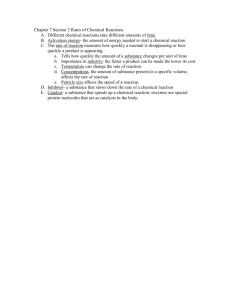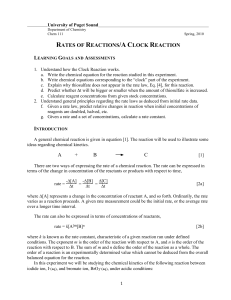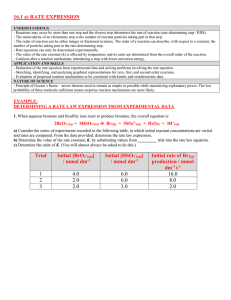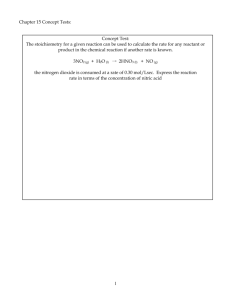EXPERIMENT 3.1 CHEMICAL KINETICS
advertisement
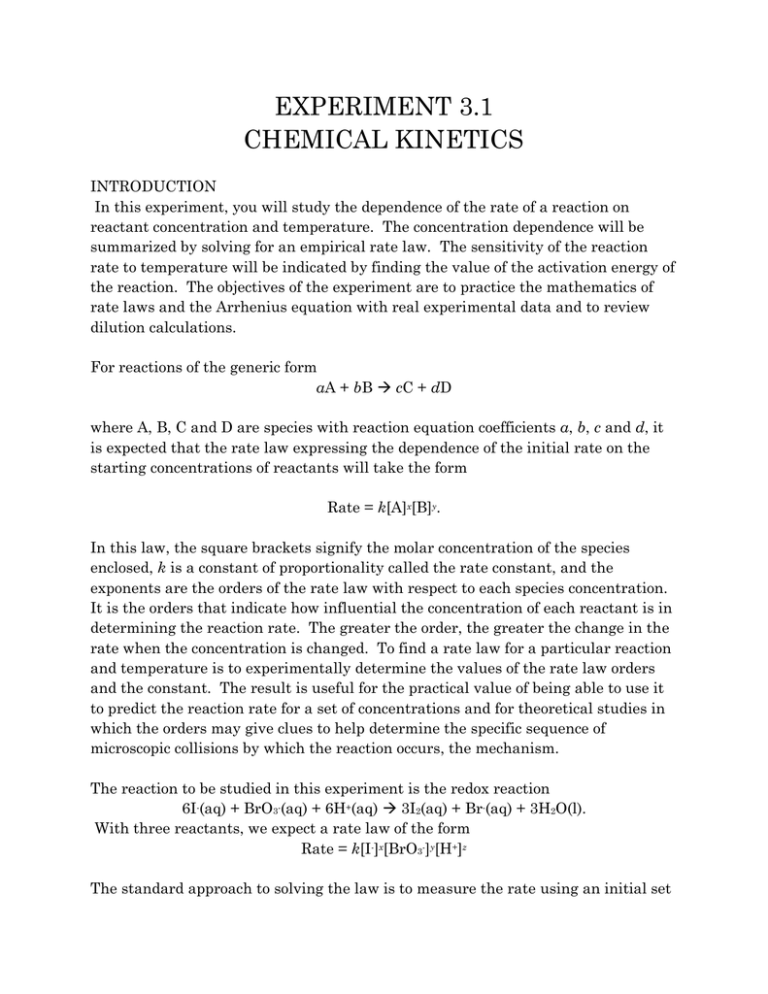
EXPERIMENT 3.1 CHEMICAL KINETICS INTRODUCTION In this experiment, you will study the dependence of the rate of a reaction on reactant concentration and temperature. The concentration dependence will be summarized by solving for an empirical rate law. The sensitivity of the reaction rate to temperature will be indicated by finding the value of the activation energy of the reaction. The objectives of the experiment are to practice the mathematics of rate laws and the Arrhenius equation with real experimental data and to review dilution calculations. For reactions of the generic form aA + bB cC + dD where A, B, C and D are species with reaction equation coefficients a, b, c and d, it is expected that the rate law expressing the dependence of the initial rate on the starting concentrations of reactants will take the form Rate = k[A]x[B]y. In this law, the square brackets signify the molar concentration of the species enclosed, k is a constant of proportionality called the rate constant, and the exponents are the orders of the rate law with respect to each species concentration. It is the orders that indicate how influential the concentration of each reactant is in determining the reaction rate. The greater the order, the greater the change in the rate when the concentration is changed. To find a rate law for a particular reaction and temperature is to experimentally determine the values of the rate law orders and the constant. The result is useful for the practical value of being able to use it to predict the reaction rate for a set of concentrations and for theoretical studies in which the orders may give clues to help determine the specific sequence of microscopic collisions by which the reaction occurs, the mechanism. The reaction to be studied in this experiment is the redox reaction 6I-(aq) + BrO3-(aq) + 6H+(aq) 3I2(aq) + Br-(aq) + 3H2O(l). With three reactants, we expect a rate law of the form Rate = k[I-]x[BrO3-]y[H+]z The standard approach to solving the law is to measure the rate using an initial set of concentrations, then to systematically change the concentration of one reactant at a time and measure the new rates. The effect of each change allows an order to be found. When all of the orders are known, one can solve for the constant k at the temperature observed. Of course, the first requirement in this approach is to have a method for the rate measurement. That is, we must be able to determine the number of moles or moles per liter of change in one of the reactants or products over a measured time span short enough that the reactant concentrations will not change significantly. To accomplish this, we will introduce a secondary reaction to provide a visual indicator for the moment that a fixed extent of reaction has occurred. In the presence of a starch indicator, the molecular iodine, I2, produced by the primary reaction gives a blue color to the solution. If only starch and the three reactacnts are combined, one will see this blue color develop immediately. However, if thiosulfate ion, S2O32- , is also present in the reaction mixture, it will react quickly with the I2 as it is produced by the reaction I2(aq) + 2S2O32-(aq) 2I-(aq) + S4O62-(aq). Thus as long as there is excess thiosulfate, the I2 will be consumed and the blue color will not develop. If the thiosulfate is used up, the blue will appear. We will add the same number of moles per liter of thiosulfate to each reaction trial and make it the limiting reactant. Thus if we measure the time required for the appearance of the blue color, we can calculate a reaction rate in units of moles per liter of thiosulfate per second.. After using rate measurements to find the rate law, we will test it by solving for the rate for a new set of concentrations and comparing our result to experimental measurement. The second objective of our study is to find the dependence of the reaction rate constant k on the temperature. This dependence is indicated by the value of the activation energy of the reaction, Ea. The activation energy is the increase in potential energy of the reacting particles necessary to break bonds and allow for the change from reactants to products. The higher the amount of this energy barrier, the more the reaction rate will change as temperature changes. We will find its value by measuring the rate at several temper-atures using constant initial concentrations and graphing the logarithm of the rate constants versus the reciprocal of the absolute temperatures. According to the Arrhenius equation, the slope of such a graph should equal the negative of the activation energy divided by the gas law constant R. MATERIALS AND SAFETY The reactant concentrations that will be used are all less than 0.10 M. All materials can be disposed of in the sinks after trial measurements are made. Nevertheless, take care to avoid unnecessary contact with the strong acid HCl and the oxidizing agent KBrO3. Wear safety goggles at all times. PROCEDURE PART A. EMPIRICAL RATE LAW Refer to the table below for the volumes of reactant solutions and water to be mixed together for each of five timed trials. Each material will be in a reservoir with a large and small graduated cylinder dedicated to it. Use the large cylinder to collect solutions from the reservoir, then pour from the large cylinder into the small cylinder to measure the amount to add to your reaction mixture. Leave excess solution in the large cylinder for the next person to use. We do not want the reaction to begin until all ingredients are together, so the oxidizing and reducing agents must be kept apart. Use two 250 mL Erlenmeyer flasks for each trial. Have one team member gather the three components specified for flask 1 while the other partner gathers the three components for flask 2. Meet back at the drawer area, measure the temperature in one of the flasks, then pour them together and begin timing. Record the time required for the blue color to appear. Trial 1 2 3 4 5 0.01 M KI 10 mL 20 mL 10 mL 10 mL 7.5 mL Flask 1 0.001 M Na2S2O3 10 mL 10 mL 10 mL 10 mL 10 mL H2O 10 mL 0 mL 0 mL 0 mL 10 mL 0.04 M KBrO3 10 mL 10 mL 20 mL 10 mL 7.5 mL Flask 2 0.1 M HCl 10 mL 10 mL 10 mL 20 mL 15 mL Starch 3 drops 3 drops 3 drops 3 drops 3 drops PART B. TEMPERATURE DEPENDENCE Consider trial 1 from part A as the first data point in this section also. Using the same reactant amounts as in trial 1, find the times required for at least two (preferably three) reactions run at different temperatures. To achieve higher temperatures, collect the ingredients in the two flasks as before. Obtain two plastic bowls from the cart and fill them with hot tap water. Immerse the flasks in the hot tap water, holding a thermometer in one of them. Do not transfer the thermometer between flasks. When the temperature is within a few degrees of your objective, mix the two solutions, start timing, and note the temperature of the mixture. Try to hold this temperature for the duration of the reaction. If the temperature begins to fall, place the flask back in the hot water. If it rises above the set point in the hot water, take the flask out again. When the color change occurs, record both the time and the temperature of the trial. To achieve a lower temperature, mix about four parts cold tap water with one part ice in the plastic bowls. Immerse the flasks in the ice baths until one reaches the target temperature (avoid letting the flask temperatures go below 5°C), then combine. Use the ice bath in the same way as the hot water bath to keep the reaction temperature as constant as possible once the reaction has been started. Record the time and temperature when the color change occurs. After completion, ask if another group can make use of the ice bath before discarding it. Check the amount of time available to determine the number of trials you can complete. If time permits, add trials at temperature in the areas of 40°C, 30°C, and 5°C. If you are running out of time, omit the 30°C trial. Clean up and return materials to the cart or drawer when finished. CALCULATION NOTES As the reaction mixtures are prepared and then combined, each of the reactants is diluted from the concentrations in the reservoirs by the increase in solution volume. Recall that the resulting concentration can be found by the equation below which is based on the number of moles of solute staying constant during dilution. Mconc × Vconc = Mdil × Vdil Use this equation to find the initial concentrations of reactants in the combined solutions as directed in practice question 1. To determine the orders of the rate laws, consider two trials in which only the concentration of species A changes from [A]1 to [A]2. If the reaction rate changed from Rate1 to Rate2, then the order of the rate law with respect to [A] is found from the relation Rate2 [A]2 Rate1 [A]1 x By taking the logaritm of both sides of the equation we obtain Rate2 log Rate1 x= [A]2 log [A]1 Rate law orders are frequently found to be whole numbers (although not always) so you may use judgement in determining if it is reasonable to round to nearest whole numbers based on the calculated results. PRELAB QUESTIONS 1. To facilitate the calculation if the rate law orders, calculate the concentration of each reactant in trials 1 through 5 (part A) after the flask contents have been combined but before reaction takes place. In the table below [I-] = [KI], [BrO3-] = [KBrO3], and [H+]=[HCl]. We only list the ions, because they are what react in the net ionic equation. Enter the concentrations you calculate into your table in your lab notebook. Create and fill in this table in your laboratory notebook as part of your prelab: Trial 1 2 3 4 5 [I-] ____________ ____________ ____________ ____________ ____________ [BrO3-] ____________ ____________ ____________ ____________ ____________ [H+] ____________ ____________ ____________ ____________ ____________ 2. Determine the molarity of the thiosulfate ion initially present in the combined reaction mixture. Have the insructor check your work. This is the number you will divide by the reaction time in seconds to obtain the relative rate for each trial. PART A DATA – create the following table in your lab notebook as part of your prelab. For each trial, record the reaction temperature (to verify that is does not vary significantly) and the time required for the reaction to consume the thiosulfate in seconds. Then, referring to practice question 2, calculate the rate as moles per liter of thiosulfate per second. TRIAL 1 2 3 4 5 Temperature ____________ ____________ ____________ ____________ ____________ Time ____________ ____________ ____________ ____________ ____________ Rate ____________ ____________ ____________ ____________ ____________ PART B DATA – Create the following table in your lab notebook as part of your prelab. Copy the data from trial 1 of part A as the first data point in this section. Then, for each trial at different temperature, record the reaction temperature and time in seconds. Calculate the rate for each trial. TRIAL 1 6 7 8 Temperature ____________ ____________ ____________ ____________ Time ____________ ____________ ____________ ____________ Rate ____________ ____________ ____________ ____________ POSTLAB CALCULATIONS PART A To determine the rate law, you will first find the order with respect to each reactant. Show work in the space provided and use logarithms to find the real number value of each order. If appropriate and reasonable based on results, round to whole numbers. b) Compare trials 1 and 2 to determine the rate law exponent for [I-]: Rate law exponent for [I-]? c) Nearest whole number? d) Compare trials 1 and 3 to determine the rate law exponent for [BrO3-]: Rate law exponent for [BrO3-]? e) Nearest whole number ? f) Compare trials 1 and 4 to determine the rate law exponent for [H+]: Rate law exponent for [H+]? g) Nearest whole number ? h) Write the complete rate law including all exponents. Next, you are to find the value and units of the rate law constant, k. i) Substitute the values for the concentrations and rate for trial 1 and solve for k. k1 ____________ j) Substitute the values for the concentrations and rate for trial 2 and solve for k. k2 ____________ k) Substitute the values for the concentrations and rate for trial 3 and solve for k. k3 ____________ l) Substitute the values for the concentrations and rate for trial 4 and solve for k. k4 ____________ m) Average of k values ____________ As a test of the rate law, use the average value of k and the concentrations of trial 5 to calculate a predicted rate for that trial. Compare the result to your measured rate (item (a)) by calculating the percent difference between them. n) Predicted rate? o) Percent difference from measured? POSTLAB CALCULATIONS PART B l) For each trial, calculate a rate constant, k (which should vary with the temperature). Also find the natural logarithm of k, ln(k); convert the temperature to Kelvins; and calculate the reciprocal of the Kelvin temperature. TRIAL k 1 ____________ 6 ____________ 7 ____________ 8 ____________ ln(k) ____________ ____________ ____________ ____________ T (in K) ____________ ____________ ____________ ____________ 1/T ____________ ____________ ____________ ____________ On the graph paper in your lab notebook, or using the page that follows, or using a spreadsheet program plot ln(k) versus 1/T. Choose appropriate scales so that the minimum and maximum values are well separated in your graph plotting ln(k) versus 1/T. Use a straight edge and/or calculator or spreadsheet program to draw a line that best fits the data and measure its slope. If you rely on a calculator or spreadsheet application for slope determination, make a note in your notebook and summarize what you did.

